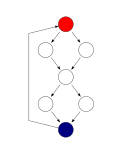References
- ↑ Anand, Saswat; Patrice Godefroid; Nikolai Tillmann (2008). "Demand-Driven Compositional Symbolic Execution". Tools and Algorithms for the Construction and Analysis of Systems. Lecture Notes in Computer Science. Vol. 4963. pp. 367–381. doi:10.1007/978-3-540-78800-3_28. ISBN 978-3-540-78799-0.
- ↑ Boonstoppel, Peter; Cadar, Cristian; Engler, Dawson (2008). "RWset: Attacking Path Explosion in Constraint-Based Test Generation". In Ramakrishnan, C. R.; Rehof, Jakob (eds.). Tools and Algorithms for the Construction and Analysis of Systems. Lecture Notes in Computer Science. Vol. 4963. Berlin, Heidelberg: Springer. pp. 351–366. doi: 10.1007/978-3-540-78800-3_27 . ISBN 978-3-540-78800-3. "the number of distinct paths increases exponentially with the number of conditional statements traversed. In all but the smallest programs, this typically leads to an essentially inexhaustible set of paths to explore."
- ↑ Ma, Kin-Keng; Khoo Yit Phang; Jeffrey S. Foster; Michael Hicks (2011). "Directed Symbolic Execution". Proceedings of the 18th International Conference on Statis Analysis. Springer. pp. 95–111. ISBN 9783642237010 . Retrieved 2013-04-03.
